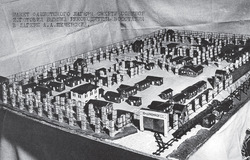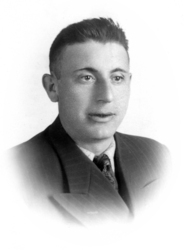Sobibor Death Camp
Sobibor
The Sobibor extermination camp came into being in May 1942, near the Polish village of Sobibor within the Lublin region (within the German occupied General government) and it was part of Operation Reinhardt. It has been estimated that the numbers of Jews murdered within this camp sits at 250,000 - 300,000 (see 'The Oxford Companion to World War II' (2005) p795. by John Keegan) but the exact figures cannot be known for sure. The camp's first commandant was SS-Obersturmführer (1st Lieutenant) Franz Stangl, a veteran of Germany's euthanasia programme (T4) and therefore had extensive experience in the art of murder. At the end of August 1942, Stangl was sent to run the Treblinka extermination camp, he would be replaced with SS-Obersturmführer Franz Reichleitner.
The actual camp itself was broken down into the following areas:
Vorlager: Which housed the main entrance into the camp, the unloading ramp, guardhouse, SS barracks and kitchens, ammunition depot and a bowling alley for the guards.
Lager I: Commanded by Oberscharführer (staff sergeant) Franz Frenzel. It housed barracks for prisoners, various prisoner workshops, prisoner’s kitchen and bakery and a prisoner latrine.
Lager II: Held a small vegetable garden, laundry room and other prisoner workshops, warehouses to store and sort out property of those murdered, including their clothes, the camps administration building and SS accommodation, stable, and camp generator. This Lager also contained an area where prisoners were expected to strip naked prior to being sent to the gas chambers, it also contained a barbers shed where female prisoners would have their hair sheared as well as the entrance to the "Schlauch" (the tube) which was simply used as a path by those condemned to the gas chambers.
Lager III: Gas chambers and burial pits. Later when the bodies were to be exhumed for cremation, pits were dug to burn them and to bury their ashes. This Lager also contained barracks for prisoners working within this area.
Lager IV: Referred to as the northern camp but only partially built, designed to store captured ammunition and other storehouses.
(Source for camp breakdown can be found at: https://www.majdanek.eu/en/news/78th_anniversary_of_the_commencement_of_mass_deportations_to_the_german_nazi/1239)
The killing Process:
After arriving at the camp via transports (trains) the victims were taken to a reception area where they were forced to remove all their clothing, their valuables were then seized, and their body hair was then shaved off. They were then driven through the tube (the Schlauch) which was about 3 metres wide and 150 metres long which led to the gas chambers. At first only about 500 victims could be dispensed with on a daily basis but this number increased after September 1942 to about 1,200. Carbon monoxide gas was then pumped into the gas chambers to extinguish the life of all those contained within. At first, the victims were simply tossed into a mass grave and buried, but later, in an attempt to hide their crimes, pits were dug and the bodies cremated.
Some Jewish prisoners who had been temporarily spared the gas chambers were forced to act as slave labourers within the camp began to contemplate an escape. The leader of this group was Leon Feldhandler, who worked closely with a Jewish Red Army officer, who was also a prisoner within the camp to stage a mass breakout.
Sobibor: The Uprising and Breakout!
The leader of the resistance within Sobibor, Feldhandler, had no military expertise and struggled to formulate a plan of action against the guards.
Later, after a batch of Soviet Jewish POWs arrived in Sobibor, their leader was Alexander Pechersky, who was simply known as 'Sasha'. When Pechersky and his men arrived at Sobibor, Feldhandler quickly made contact with him and after a little while, they had come up with a plan to free, not just some prisoners, but all of the prisoners in an armed uprising.
They began by gaining access to the Ukrainian guard’s barracks where they managed to steal some rifles. Other weapons such as knives were secretly made within the camp's workshops. The plan was to wait until the camp commandant was away on business and then strike. They would then lure key SS personnel, especially the commander's deputy, into some of the workshops with the promise of them acquiring some item or other. They would also ensure that the camp's communications would be down so that they could not call for assistance when the rebellion began. The signal to begin the revolt would be initiated at one of the daily roll calls. The primary exit route would be through the camp's main gate, thus avoiding the heavily mined camp perimeters.
On the 14 October 1943, the plan was initiated, soon nine guards were dead (8 SS officers and 1 Ukrainian). But when the camp deputy didn't show up at the area designated for his assassination, two Jews were dispatched to his office to liquidate him, which they did manage to achieve. Then as Feldhandler attempted to get the 600 strong Jewish slave labour force to rise up, the plan began to unravel. An SS guard became suspicious at the roll call and he was quickly killed on the spot. Suddenly, seeing this, the Ukrainians within the guard towers began to open fire on the prisoners who had assembled for roll call, which in turn began to cause mayhem. Soon SS men were firing into the crowd of assembled Jews. The plan to rush the main gate was abandoned and most of the prisoners rushed the fences, which gave way and some 320 managed to escape into the woods beyond the perimeter. Others died trying.
Out of the 320 who got past the perimeter, at least 170 were recaptured and shot. At least 150 escaped deep into the nearby forest. Some managed to link up with local partisan groups. The fight to stay free became a struggle in itself as some local Poles betrayed their whereabouts to the Nazis for financial gain, and some Poles simply just murdered them.
As a result of the uprising, Heinrich Himmler ordered the camp to be dismantled and evidence of its existence eradicated. The camp was liquidated in October 1943 and a farm and trees planted over the site.

